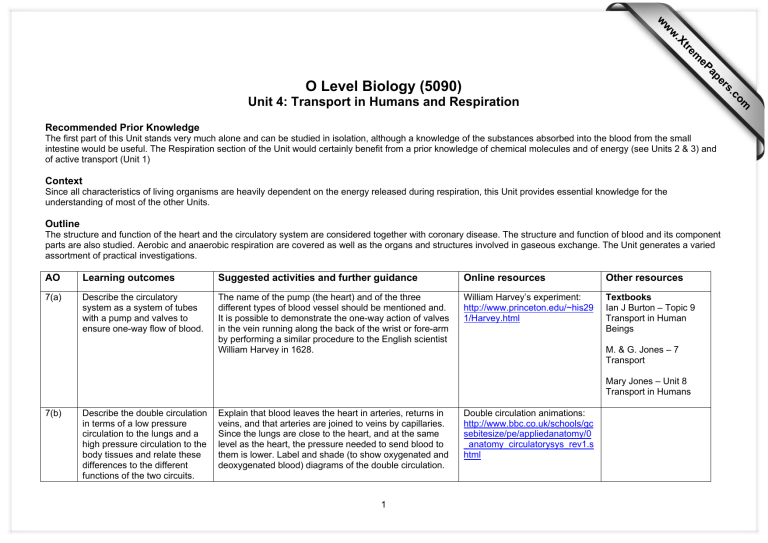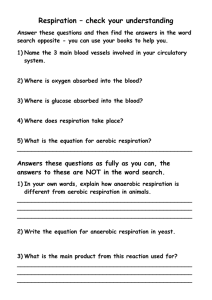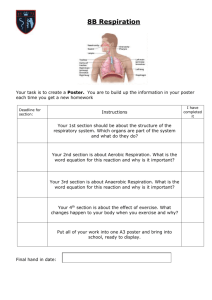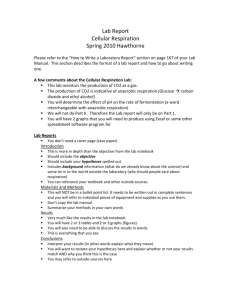O Level Biology (5090) Unit 4: Transport in Humans and Respiration www.XtremePapers.com

www.XtremePapers.com
O Level Biology (5090)
Unit 4: Transport in Humans and Respiration
Recommended Prior Knowledge
The first part of this Unit stands very much alone and can be studied in isolation, although a knowledge of the substances absorbed into the blood from the small intestine would be useful. The Respiration section of the Unit would certainly benefit from a prior knowledge of chemical molecules and of energy (see Units 2 & 3) and of active transport (Unit 1)
Context
Since all characteristics of living organisms are heavily dependent on the energy released during respiration, this Unit provides essential knowledge for the understanding of most of the other Units.
Outline
The structure and function of the heart and the circulatory system are considered together with coronary disease. The structure and function of blood and its component parts are also studied. Aerobic and anaerobic respiration are covered as well as the organs and structures involved in gaseous exchange. The Unit generates a varied assortment of practical investigations.
AO Learning outcomes Suggested activities and further guidance Online resources Other resources
7(a) Describe circulatory system as a system of tubes with a pump and valves to ensure one-way flow of blood.
7(b)
The name of the pump (the heart) and of the three different types of blood vessel should be mentioned and.
It is possible to demonstrate the one-way action of valves in the vein running along the back of the wrist or fore-arm by performing a similar procedure to the English scientist
William Harvey in 1628.
William Harvey’s experiment: http://www.princeton.edu/~his29
1/Harvey.html
Textbooks
Ian J Burton – Topic 9
Transport in Human
Beings
M. & G. Jones – 7
Transport
Mary Jones – Unit 8
Transport in Humans
Describe the double circulation in terms of a low pressure circulation to the lungs and a high pressure circulation to the body tissues and relate these differences to the different functions of the two circuits.
Explain that blood leaves the heart in arteries, returns in veins, and that arteries are joined to veins by capillaries.
Since the lungs are close to the heart, and at the same level as the heart, the pressure needed to send blood to them is lower. Label and shade (to show oxygenated and deoxygenated blood) diagrams of the double circulation.
Double circulation animations: http://www.bbc.co.uk/schools/gc sebitesize/pe/appliedanatomy/0
_anatomy_circulatorysys_rev1.s
html
1
7(c)
7(d)
7(e)
Name the main blood vessels to and from the heart, lungs, liver and kidneys.
Describe the structure and function of the heart in terms of muscular contraction and the working of valves.
Compare the structure and function of arteries, veins and capillaries.
A simplified, labelled, demonstration diagram of only those blood vessels specified should first be explained, and then a similar unlabelled diagram might be provided for students to label.
A labelled demonstration diagram may be used to provide the correct terminology for the structures of the heart and to explain the heart cycle and the action of valves. Stress that both atria contract together, followed by both ventricles – rather than the right side contracting first to send blood to the lungs, followed by the left side to send blood to rest of the body. As above, an unlabelled diagram should be provided for students to label. A demonstration dissection of a heart may be carried out, although be alert to the possible sensibilities of individual students.
TS drawings of of all three vessels should be supplied – together with a LS of a vein to show semi-lunar valves.
Annotations on the diagrams can be used to link structure with function. Compare the nature of blood flow in each.
Ask students to use their knowledge to identify the type of blood vessel labelled A and B in the online resource and to write a paragraph to explain how their structure and functions can be compared.
Use the blood vessel animation online resource to show the flow of blood through vessels under a range of conditions. Note the action of valves in veins.
Simplified vessel diagram: http://www.ringwoodbiology.co.u
k/rotheryimages/dblcirc.gif
Circulatory system animations: http://apan.net/meetings/busan0
3/materials/ws/education/demolos/bloodrlo/circulatorysystem.swf
Heart structure diagrams: http://www.bbc.co.uk/schools/gc sebitesize/pe/appliedanatomy/0
_anatomy_circulatorysys_rev2.s
html
Blood vessel struc. and funct. http://www.scool.co.uk/gcse/biology/heartand-circulation/bloodvessels.html
Artery and vein TS: http://www.bioclix.org/images/art eryvein.jpg
Blood vessel animations: http://www.medmovie.com/mmd atabase/MediaPlayer.aspx?Clie
ntID=65&TopicID=771
Bioscope CD
TS of artery and of vein
2
7(f)
7(h)
7(i)
Investigate and state the effect of physical activity on pulse rate. disease in terms of the occlusion of coronary arteries and state the possible causes
(diet, stress and smoking) and preventive measures.
Identify red and white blood cells as seen under the light microscope on prepared slides, and in diagrams and photomicrographs.
List the components of blood as red blood cells, white blood cells, platelets and plasma.
Students should locate an artery (e.g. at their wrist or at the side of the neck) and count and record the rate of the pulse at rest. The number of beats per 15 sec should be recorded and multiplied by 4 to give beats per minute.
Students should work in pairs – one as the researcher and one as the subject, who takes two minutes brisk exercise.
Immediately afterwards, the researcher takes the pulse rate for 15 sec every minute until the rate returns to normal. Graphs may be drawn of rate (beats per minute) against time. Data for the whole class may be pooled if they all perform exactly the same exercise and the investigation used as an opportunity to discuss control of variables.
This outcome links with Unit 3. Saturated fats and cholesterol should be mentioned as being constituents of atheroma. The need for exercise should be stressed – as well as other precautions, especially if there is a family history of heart disease .
Students may write a commentary to the suggested online resource to list the steps in development of atheroma. A list of the possible causes and preventative measures, in the form of a table, may accompany the diagram.
Students should note the paler colour of red blood cells towards their centres, the different comparative sizes and numbers of red and white cells, and that there are different types of white cell (their different names are not required). Note that the colours of the cells are as seen after staining and are not their natural colours.
CHD site including animation: http://hcd2.bupa.co.uk/fact_shee ts/html/coronary_heart_disease.
html
Blood cell photomicrograph: http://www.fazaclo.com/Images/r ed_white_blood_cells.jpg
Constituents of blood: http://www.pennmedicine.org/he alth_info/images/19432.jpg
Bioscope CD
Human Blood
3
7(j)
7(k)
8(a)
State the functions of blood: red blood cells – haemoglobin and oxygen transport; white blood cells – phagocytosis, antibody formation and tissue rejection; platelets – fibrinogen to fibrin, causing clotting; plasma – transport of blood cells, ions, soluble food substances, hormones, carbon dioxide, urea, vitamins and plasma proteins.
Describe the transfer of materials between capillaries and tissue fluid.
Prepare a table to show the name and functions of each type of blood cell. The table may be extended to show a diagram of cells seen in 7(h) above.
The ability of haemoglobin to absorb and to release oxygen should be mentioned. Link to 5(d) in Unit 3.
Students may write a commentary to the animations.
Invite suggestions about why transplants are likely to be more successful between closely related people.
Fibrinogen should be introduced as a plasma protein. The role of the clotting process and formation of a scab in preventing entry of pathogens should be included.
Students may watch the suggested online animation and write an accompanying commentary.
Define respiration as the release of energy from food substances in all living cells.
Action of white blood cells: http://www.bbc.co.uk/schools/gc sebitesize/science/aqa/human/d efendingagainstinfectionrev4.sht
ml
Phagocytosis animation: http://www.edumediasciences.com/en/a82phagocytosis
Blood clotting animation: http://www.footprintsscience.co.uk/flash/blood.swf
Capillaries may be thought of as ‘leaky’, but their walls will not allow large molecules to pass. Plasma proteins are too large to do so, as are blood cells with the exception of some WBCs which are able to change shape to squeeze through and reach a site of infection. This description will allow students to differentiate between plasma and tissue fluid. Stress the two-way movement of materials – with metabolic products able to pass from cells into capillaries.
Cross-reference 5(p) in Unit 3 and 8(k) in Unit 4.
It is essential at this stage to differentiate between breathing and respiration. It should be made clear that respiration is a chemical reaction occurring in all living cells with the sole purpose of releasing energy. Also stress that energy is not ‘needed’ for respiration and that respiration does NOT ‘create’ or ‘produce’ energy. Note that the definition allows for respiratory substrates other than glucose, although glucose is the only one required by the syllabus.
Aerobic and anaerobic respiration: http://www.scool.co.uk/gcse/biology/respirati on.html
Note: this resource is relevant to many of the subsequent learning outcomes in this Unit.
Textbooks
Mary Jones – Unit 9
Respiration
Ian J. Burton – Topic 10
Respiration
M. & G. Jones – 6
Respiration
4
8(b)
8(c)
8(d)
8(e)
8(f)
Define aerobic respiration as the release of a relatively large amount of energy by the breakdown of food substances in the presence of oxygen.
State the equation (in words or symbols) for aerobic respiration.
Name and state the uses of energy in the body of humans: muscle contraction, protein synthesis, cell division, active transport, growth, the passage of nerve impulses and the maintenance of a constant body temperature.
Define anaerobic respiration as the release of a relatively small amount of energy by the breakdown of food substances in the absence of oxygen.
State the equation (in words or symbols) for anaerobic respiration in humans and in yeast.
Students should realise that during this process the glucose is completely broken down to its constituent molecules, releasing all of the energy absorbed in building the molecule.
In Unit 2 students have learnt the equation for photosynthesis and that the process is the reverse of respiration. Again, a word equation is acceptable, but if symbols are used the equation must balance (it is acceptable to add ‘+ energy released’ on the right hand side).
This outcome allows for the introduction of the concept of energy being required to build large molecules other than glucose or starch. Two further types of energy are also introduced – heat energy and electrical energy, to add to light and chemical energy so far considered in Unit 2.
Students may produce a ‘spider diagram’ to state the uses of energy and may illustrate their diagram with handdrawn or printed pictures and/or further annotations.
This is likely to be a new concept for students. It may be explained that in the absence of oxygen, the respiratory substrate is not completely broken down into its constituent molecules. Some chemical energy therefore remains in the molecules produced in the reaction, leaving less to be released than in aerobic respiration.
Two forms of anaerobic respiration are relevant to the syllabus. Both should be given with a clear explanation that one form is encountered in fermentation (Unit 6) and the other in muscle action. Word equations are likely to be more easily accessible to students at this level.
5
8(g)
8(h)
Describe the effect of lactic acid production in muscles during exercise.
Know the percentages of gases in atmospheric air and investigate and state the differences between inspired and expired air.
Ask students to raise their arm and to open and close their fist in quick succession for as long as possible. The resulting discomfort is a result of lactic acid build up in the muscles. Whilst discussing the concept with students, sufficient time will elapse for the discomfort to subside – a result of the lactic acid being broken down into harmful carbon dioxide and water. Use the stimulus photo of a runner with muscle cramp to elucidate ideas.
This can be related to the build-up of lactic acid during exercise. Cramp often strikes after exercise has finished - a result of the circulation not being able to remove the lactic acid quickly enough from the muscles - refer to 7(k).
A table of differences – with approximate percentages – should be given. Students may use this data to plot pie charts of gas composition and to produce written explanations of the similarities and differences apparent.
The table above should be supported by a practical investigation of the comparative amounts of CO
2
and water vapour in air, and of differences in temperature.
Students may breathe out through limewater indicator to show presence of CO
2
in exhaled air. The demonstration may be extended to the ‘huff-puff’ apparatus to show more
CO
2
is present in exhaled than inhaled air.
Breathing into a test-tube of water at laboratory temperature for several minutes (to demonstrate temperature of expired air) and onto dried cobalt chloride paper (to show presence of moisture) may be suitable investigations depending on ambient temperature and humidity.
Marathon runner stimulus photo: http://gobblegreen.com/blog/wpcontent/uploads/2009/08/runnerwith-muscle-cramp-bycesareb.jpg
Composition of air table: http://www.yteach.co.uk/page.ph
p/resources/view_all?id=diaphra gm_expiration_hemoglobin_insp iration_pleura_respiratory_syste m_lungs_t_page_22
Huff-puff apparatus: http://www.chemistrydaily.com/c hemistry/upload/6/68/Huff_%27n
%27puff_equipment.png
6
8(i)
8(j)
8(k)
8(l)
Investigate and state the effect of physical activity on rate and depth of breathing.
Identify on diagrams and name the larynx, trachea, bronchi, bronchioles, alveoli and associated capillaries.
State the characteristics of, and describe the role of, the exchange surface of the alveoli in gas exchange.
Describe the role of cilia, diaphragm, ribs and intercostal muscles in breathing.
Students will be aware that they breathe more deeply after exercise. This knowledge should be supported with an illustrative graph (which would also show the change in rate of breathing). A spirometer, if available, may be used to generate such a graph both before and after exercise.
Working in pairs, with one student as the subject, breathing rates before and after exercise may be measured (using the ‘count for 15 sec then multiply by 4’ method – repeated for 10 minutes after the exercise).
Graphs may be drawn of the results and compared with those obtained in 7(f) above.
A labelled OHP transparency of the contents of the thorax could be shown and described to the students. Include only the labels specified (plus the diaphragm, ribs and intercostals muscles covered later). Supply students with an unlabelled version for them to label.
Draw attention to the small size, large number and large surface area of the alveoli. The thinness of the alveoli walls, their moist coating and the short distance between the air and the extensive networks of capillaries should also be included.
Ensure that students do not believe cilia to be hairs that filter the passing air.
Consider the mechanism by which these components result in altering the volume and pressure in the thorax.
Balloons attached to a glass tube in an air-tight bell jar with a rubber sheet stretched across its base demonstrate the principles involved. Invite students to list ways in which the demonstration does not accurately reflect the process of breathing. Pupils may construct similar models.
Spirometer trace before and after exercise: http://www.brianmac.co.uk/spiro
2.gif
Thorax labelled diagram: http://www.homebusinessandfa
milylife.com/images/respiratory_ system.gif
Gas exchange animation: http://www.bbc.co.uk/schools/gc sebitesize/pe/appliedanatomy/1
_anatomy_respiratorysys_rev3.s
html
Inhalation and exhalation: http://www.bbc.co.uk/schools/gc sebitesize/pe/appliedanatomy/1
_anatomy_respiratorysys_rev1.s
html
Pupil-constructed model: http://www.practicalbiology.org/a reas/advanced/cells-tosystems/ventilationsystems/modelling-the-humanventilation-system,119,EXP.html
Bioscope CD
Lung (showing alveoli)
7



